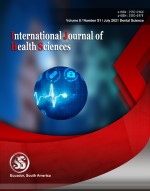Case report of retained deciduous 2nd molars in an adult patient having congenitally missing mandibular 2nd premolars
Keywords:
hypodontia, retained deciduous teeth, adult patientAbstract
Hypodontia is sometimes observed in adult patients and is frequently associated with missing 3rd molars. However, it can also involve other teeth such as canines, lateral incisors and premolars. In this case report, we describe a case of an adult patient having bilaterally missing mandibular second premolars and instead, presence of retained deciduous 2nd molars. Also, a possible insight into the etiology of retained deciduous teeth is discussed.
Downloads
References
Bredy F. Erbring C.Hubenthal B. The incidence of hypodontia with prescence and abscence of wisdom teeth.Disch Zahn Mund Kieferheilkd Zentralbl 1991;79:357-363.
Lynham A. Panoramic radiographic survey of Hypodontia in Australian defence recruits.Aust Dent J1990:35:19-22.
Garn SM,Lewis AB. The relationsdhip between 3rd molar agenesis and reduction in tooth number.Angle Orthod. 1962;32(14-8).
Rose JS. A Survey of congenitally missi ng teeth excluding 3 rd molars in 6000 orthodontic Patients. Dent Pract Dent Rec.1966;17(3):107-13
Pannu P,Kaur A,Simratvir M, Suljana A. Agenesis of Permanent Mandibular Anterior teeth: A case report. Journal of Dent for Children.78:1,2011
Brook A.H.: Multilevel complex interactions between genetic, epigenetic and environmental factors in the aetiology of anomalies of dental development. Arch. Oral Biol., 2009; 54, S3-S17.
Kapadia H., Mues G., D’Souza R.: Genes affecting tooth morphogenesis. Orthod. Craniofac. Res., 2007; 10: 105-113
Kohli S.S., Kohli V.S.: A comprehensive review of the genetic basis of cleft lip and palate. J. Oral Maxillofac. Pathol., 2012; 16: 64-72.
Vieira A.R., Orioli I.M., Castilla E.E., Cooper M.E., Marazita M.L., Murray J.C.: MSX1 and TGFβ3 contribute to clefting in south America. J. Dent. Res., 2003; 82: 289-292
Vastardis, Heleni. “ The genetics of human tooth agenesis: New discoveries for understanding dental anomalies. American Journal of Orthodontics and Dentofacial Orthopedics 2000:117;6:650-656.
] Larson M., Helidust R., Jakobsson O.P.: Dentalabnormalities and ectopic eruption in patients with isolated cleft palate. Scand. J. Plast. Reconstr. Surg. Hand Surg., 1997; 32: 203-212
Suri S., Ross R.B., Tompson B.D.: Mandibular morphology and growth with and without hypodontia in subjects with Pierre Robin sequence. Am. J. Orthod. Dentofac. Orthop., 2006; 130: 37-46
] Hirschhorn K, Cooper H.L.: Apparent deletion of one chromosome (4 or 5) in a child with defects of midline fusion. Hum. Chrom. News, 1961; 4: 14
Shannon N.L., Maltby E.L., Rigby A.S., Quarrell O.W.: An epidemiological study of Wolf-Hirschhorn syndrome: life expectancy and cause of mortality. J. Med. Genet., 2001; 38: 674-679
] Wieczorek D., Krause M., Majewski F., Albrecht B., Horn D., Riess O, Gillessen-Kaesbach G.: Effect of the size of the deletion and clinical manifestation in Wolf-Hirschhorn syndrome: analysis of 13 patients with a de novo deletion. Eur. J. Hum. Genet., 2000; 8: 519-526
Wright T.J., Ricke D.O., Denison K., Abmayr S., Cotter P.D., Hirschhorn K., Keinanen M., McDonald-McGinn D., Somer M., Spinner N., Yang-Feng T., Zackai E., Altherr M.R.: A transcript map of the newly defined 165kb Wolf-Hirschhorn syndrome critical region. Hum. Mol. Genet., 1997; 6: 317-324
Zollino M., Lecce R., Fischetto R., Murdolo M., Faravelli F., Selicorni A., Buttè C., Memo L., Capovilla G., Neri G.: Mapping the Wolf- -Hirschhorn syndrome phenotype outside the currently accepted WHS critical region and defining a new critical region, WHSCR-2. Am. J. Hum. Genet.,. 2003; 75: 590-597
Babich S.B., Banducci C., Teplitsky P.: Dental characteristics of the Wolf-Hirschhorn syndrome: a case report. Spec. Care Dentist., 2004; 24: 229-231
] Jędryszek A., Kmiecik M., Paszkiewicz A.: Review of modern knowledge on hypodontia. Dent. Med. Probl., 2009; 46: 118-125
Johnston N.J. Franklin D.L.: Dental findings of a child with Wolf- -Hirschhorn syndrome. Int. J. Paediatr. Dent., 2006; 16: 139-142
Modesto A., Moreno L.M., Krahn K., King S., Lidra A.C.: MSX1 and orofacial clefting with and without tooth agenesis. J. Dent. Res., 2006; 85: 542-546
Nieminen P., Kotilainen J., Aalto Y., Knuutila S., Pirinen S., Thesleff I.: MSX1 gene is deleted in Wolf-Hirschhorn syndrome patients with oligodontia. J. Dent. Res., 2003; 82: 1013-1017
Kjaer, Inger, et al. “Aetiological aspects of mandibular tooth agenesis-focusing on the role of nerve, Oral mucosa, and supporting tissues.” The European Journal of Orthodontics 16(5)1994;371-75
Published
How to Cite
Issue
Section
Copyright (c) 2021 International journal of health sciences

This work is licensed under a Creative Commons Attribution-NonCommercial-NoDerivatives 4.0 International License.
Articles published in the International Journal of Health Sciences (IJHS) are available under Creative Commons Attribution Non-Commercial No Derivatives Licence (CC BY-NC-ND 4.0). Authors retain copyright in their work and grant IJHS right of first publication under CC BY-NC-ND 4.0. Users have the right to read, download, copy, distribute, print, search, or link to the full texts of articles in this journal, and to use them for any other lawful purpose.
Articles published in IJHS can be copied, communicated and shared in their published form for non-commercial purposes provided full attribution is given to the author and the journal. Authors are able to enter into separate, additional contractual arrangements for the non-exclusive distribution of the journal's published version of the work (e.g., post it to an institutional repository or publish it in a book), with an acknowledgment of its initial publication in this journal.
This copyright notice applies to articles published in IJHS volumes 4 onwards. Please read about the copyright notices for previous volumes under Journal History.
















